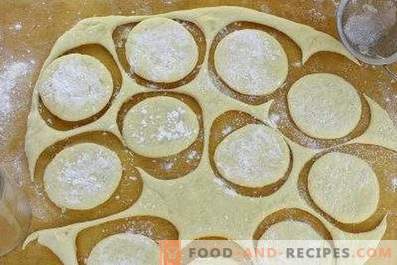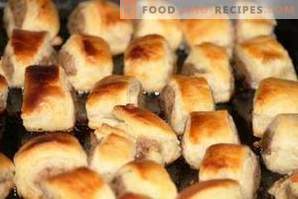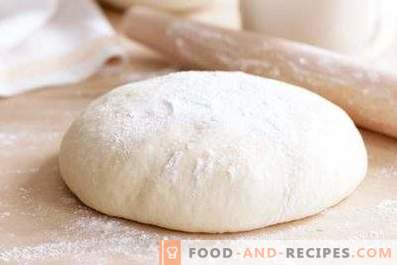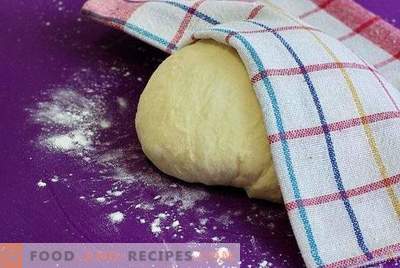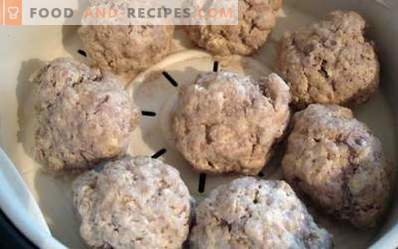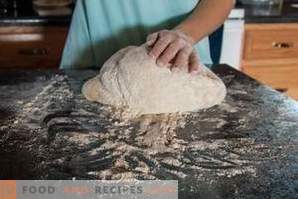
This is an unpredictable yeast dough! One time it makes great buns, and another time the dough does not even want to rise! Why it happens?
Yeast dough does not tolerate fuss. Therefore, if the hostess has little time, it is impossible to take baking pies out of this dough! After all, kneading dough is a kind of ritual. Dough, especially yeast, does not tolerate cronyism. It is alive, and when the hostess puts her whole soul into it, she responds to it gratefully.
Yeast dough does not like “one more hands”. Therefore, assistants, especially during the mixing period, should be avoided by the hostess.
During all the work with yeast dough, it is impossible to open windows or a vent as the yeast dough is afraid of drafts.
Someone thinks this is fiction, but yeast dough is afraid of even loud talk, screams and knocks.
Therefore, from what responsibility the hostess comes to the batch of yeast dough, depends on its fermentation and recovery.
If the hostess just mixes all the ingredients in a bowl, most likely she will fail - the dough will not rise. Because each ingredient needs its own approach.
Yeast
Yeast can be used both pressed and dry.
But the yeast must be fresh, not expired.
For each type of yeast there is its own order of mixing with flour. Pressed yeast must be fed before mixing. This also applies to some dry yeast. Therefore, you must read the information on the package, because there are some dry yeast, which are mixed directly with the flour.
The yeast is dissolved in a glass of warm water or milk with the addition of a teaspoon of sugar. When the liquid is covered with a cap of foam, you can proceed to the following steps.
Liquid
Most often, the recipes say that in order to grow the yeast “you need to take the heated liquid”, believing that the housewives already know everything.
But the fact is that the temperature of water or milk should not be lower than 28-30 °, but not higher than body temperature.
Indeed, in a cold or cool liquid, yeast does not multiply, and the dough does not rise.
And in a highly heated fluid, the yeast is brewed and killed. This means there will be no fermentation, and the dough will not rise.
Oil
Butter in not yet risen yeast dough is put only in a melted and slightly cooled form, so as not to disturb the fermentation.
Flour
Flour should not be cold. Therefore, it must be placed in a warm place in advance.
Flour is recommended to sift before use for saturation of oxygen. This action will help improve the test.
Kneading Yeast Dough
If the dough is rich, that is, it has a lot of fat, sugar and eggs, then it is better to put it on the broth.
Dough is made from the full volume of liquid, yeast and half the rate of flour. The dough is viscous, like pancakes. Such a dough in a warm place rises well.
When opara will increase two to three times, add the rest of the ingredients and flour.
Knead the dough well. The better the dough is kneaded, the more it will rise.
Yeast dough can not be done tight. Such dough rises poorly, and products made from it are dense, low and harden quickly.
Without dough, you can put the dough only if there is little baking in it. For example, for whites. Or if it is kneaded with a weak consistency for deep-frying.
Rising Yeast Dough
To make the dough rise well, it is put on for 1, 5-2 hours in a warm place, be sure to cover it with a thick towel, a lid or a plastic bag.
If the room is cold, the dough will not rise! In this case, a bowl of dough put on the pan with very hot water. But at the same time the bottom of the bowl should not come into contact with this water. Otherwise, the yeast will brew, die, and the dough will not rise.
To make the products from yeast dough turned out to be fluffy, the dough must be kneaded once or twice during the process of lifting, releasing carbon dioxide from it. And again give rise. Yeast dough can not be overdone. After all, it can not rise endlessly. And, fully matured, begins to fall. If the dough drops, it will not rise a second time. Products from such a dough will be sour, flat and hard.
It is necessary to choose the right dishes for kneading dough. If the pan is too spacious, then the dough in such a container blurs, but does not rise.
It is advisable to immediately knead a large amount of dough. When a lot of dough, it is well and actively wanders.
Excess yeast dough can be folded in a plastic bag, leaving some room for lifting, well tied up and put into the freezer. Thanks to this storage, the quality of the dough will not become worse. But in the fridge yeast dough can perekisnut.
Baking products from yeast dough
Formed products from yeast dough also require proofing. Only then will baking get lush and high.
Less rich yeast dough is baked at a higher temperature (220-240 °).
Sweet yeast dough is baked at 190-210 ° so that it has time to rise, but it does not burn.
